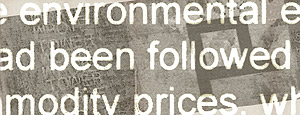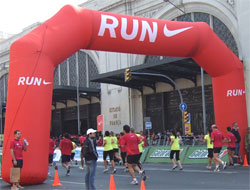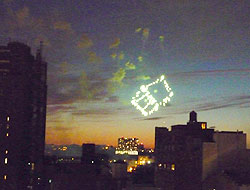A: Predicting content of a text before reading

In this group of exercises you will practise predicting content of a text or paragraph before reading.

1. What do you already know?
You are going to read a text about preparing for and running a marathon. Before you read the text, think about how much you already know about running marathons. Do you think the statements below are true or false?
2. Start with the title.
The title of the text can give you an indication of what the text is about. Look at the title of the text you are going to read.
"Marathon Training Program: Final Race Preparations and Marathon Strategy"
What information do you think the text might include? Choose from the list below. There is no feedback on this exercise. You will have to read the text to check your answers.
3. Read the text.
Look at this shortened version of the text. Were your predictions correct? Read and then answer the questions at the end of the text.
Marathon Training Program: Final Race Preparations and Marathon Strategy
Many runners fail to realize that one of the most important aspects of marathon training is the taper phase. Reducing weekly and long-run mileage during these final two weeks is vitally important so that you will be fully recovered from previous workouts while at the same time be completely rested for the big event. Assuming that the marathon is scheduled on a Sunday, we will refer to the taper phase as the time that spans the two weeks prior to the marathon right up to Saturday night before the race.
Cut back on the distance and intensity of your training runs during the two-week period prior to the marathon, eliminating long and hard efforts. You will need to make a decision whether you wish to take either (or both) Friday or Saturday as a complete leg rest day on marathon weekend. Remember, there are no workouts the week prior to the marathon that will enhance your preparedness for the race.
Running the correct pace for your ability level is crucial in the marathon, especially for the first-time marathoner. It's so easy to start the race by running at a pace which is much faster than you are prepared for. Your pace during the first mile often feels effortless due to the adrenaline rush and excitement of the event. If you run the first mile or two too fast, you'll pay dearly for the mistake in the later miles. A much better plan is to start out slower than what you hope to average and then run the middle miles at your chosen pace.
Do not pass up any fluid stations on the marathon racecourse. While it's acceptable to drink just water in the early miles, runners must consume sports beverages no later than 90 minutes into the race (and earlier if possible). Find out what works best for you in long practice runs. At a fluid station, water is usually offered at the first tables with sports beverages served near the end of the station. If necessary, walk through the aid stations to be sure that you are able to consume the entire contents of the cup. If you choose to stop and drink, be sure to stay out of the path of approaching runners.
Often during the marathon you will encounter other runners who will be running your pace and may wish to engage you in conversation. It's a personal decision as to if you wish to stick with them and chat along the way. The positive aspect of socializing is that many great friendships have been started this way, and that talking to others is a great way to take your mind off the physical discomfort you may face later in the marathon.
Adapted from "Marathon Training Program: Final Race Countdown and Marathon Strategy", by Art Liberman.
Now check your answers to exercise 2. Which information is included in the text?
4. Predicting the content of specific paragraphs.
The complete text about marathon running has six paragraphs. Look at the title of each paragraph below. Match the paragraph headings with the topic each paragraph mentions. There is one topic for each paragraph.
See the complete text.
B: Completion task practice

In this group of exercises you will do more completion task practice.
TIP:
Remember that this exercise type could include individual sentences or a paragraph. Also remember that the word limit for each space can be different (one, two or three words), so you will need to read the instructions carefully.
1. Finding the words you need.
Look at the instructions for the sentence completion task:
Complete the sentences below with words taken from the reading passage. Use NO MORE THAN THREE WORDS for each answer.
Look at the example question below. It refers to the marathon running text which you looked at in Unit 2A.
Question:
Complete the sentences below with words taken from the reading passage. Use NO MORE THAN THREE WORDS for each answer.
1. Use your _________ to decide exactly when you need to take fluids during the race.
2. Don't start running too fast. Begin slowly and move up to _________ during the middle of the race.
3. A day or two before the race it might be useful to have a _________.
4. The two-week _________ is a vital part of a runner's marathon training.
TIP:
With this task type the first step is to locate the paragraph that includes the topic mentioned in the sentence.Now match the sentences above to the paragraph headings for the text. Which paragraph do you think each sentence refers to?
2. Use the sentence to guide you.
The sentence or paragraph you have to complete can give you useful information to help you locate the answer you are looking for. Look at sentence 4 again:
The two-week _________ is a vital part of a runner's marathon training.
This tells us two important things about the words we are looking for:
- It refers to something that lasts for two weeks.
- It refers to something which is very important.
When you have found the correct paragraph, you need to read in more detail to find the words you need.
TIP:
It is important to decide on the type of words (adjective, noun, verb, etc.) that can go in the space. This will help you to eliminate distractors. Note: Distractors are words or information in the text that at first seem to be the correct answers, but which are in fact incorrect.Look at sentence 4 again:
The two-week _________ is a vital part of a runner's marathon training.
3. Making a final choice.
Look again at the first paragraph. Can you find a word or words (a noun or noun phrase) which refers to something very important that lasts for two weeks?
Many runners fail to realize that one of the most important aspects of marathon training is the taper phase. Reducing weekly and long-run mileage during these final two weeks is vitally important so that you will be fully recovered from previous workouts while at the same time be completely rested for the big event. Assuming that the marathon is scheduled on a Sunday, we will refer to the taper phase as the time that spans the two weeks prior to the marathon right up to Saturday night before the race.
Now, write the word(s) from the text to complete sentence 4:
Summary
So, with sentence completion tasks:
- Read the sentences and match them to the correct paragraph.
- Use the information in the sentences to help you find the answer.
- Decide which part of speech (noun, adjective, verb, etc.) you need.
- Your final choice needs to be a word which fits both grammatically
and in terms of meaning.
4. Practice.
Now look again at the other sentences to complete in this question. (You already have the answer for the first example.) See the marathon running text again.
5. Paragraph completion tasks.
This type of question asks you to complete a summary of all or part of the reading passage – either choosing from a list of words or using words from the text.
TIP:
It is important to read the summary quickly to get a general understanding of it.Now read a summary paragraph for the marathon running text you have been working on. Then, drag the words below to complete the paragraph. There are five extra words which you will not use.
See the text again.
Summary
So, with paragraph completion tasks:
- Read the whole paragraph quickly for general understanding. This will also help you to locate quickly the specific parts of the reading passage you will need to review.
- Read each complete sentence, paying special attention to the words before and after the space you must complete.
- Try to predict possible answers before you look back at the reading passage.
- Make sure your answer fits both grammatically and in terms of meaning.
C: Identifying main ideas in a text

In this group of exercises you will practise identifying the main ideas in a text.
TIP:
Remember, when you choose a heading for a paragraph or text you need to choose the heading which summarises the complete text.

1. Topic sentences.
You are going to read a text called "A brief history of fireworks". Look at one of the paragraphs from the text and choose the correct heading.
For example, the paragraph you looked at begins:
Fireworks rapidly became a very popular form of entertainment.
This suggests that the paragraph will talk about the use of fireworks for special occasions and celebrations, which is the topic of the paragraph.
2. Choosing the correct heading using the topic sentence.
Now look at the list of headings in the drop-down menus for the complete "A brief history of fireworks" text. Then look at the topic sentences below. Choose the correct heading for each topic sentence.
TIP:
Reading the first sentence of each paragraph can be very useful with this type of matching task. It can also help you to know where to look in order to answer other types of questions. With tasks in which you match headings to paragraphs, remember the following:
- Read all of the headings first before you begin reading the text.
- Complete the task in the order in which the answers appear in the text.
- Leave the most difficult paragraphs and return to them later.
- Cross off the headings as you use them.
- Be careful with distractors (headings which you don't need to use). They often refer to information which is included in the paragraph, but they don't summarise the complete passage.
3. Paragraph completion task.
Look at this summary of the text "A brief history of fireworks". Before you try to complete the paragraph, identify which topics are mentioned in it. Read the paragraph and choose from the topics below.
Fireworks were discovered by (1) ____________ in China when a cook mixed three common kitchen ingredients. The mixture (2) __________ brightly-coloured flames. At first the new (3) __________ was used to entertain, but slowly it started to be used in a (4) __________ of different ways. By the 13th century fireworks were also being used in (5) __________ by the Chinese against the Mongols. In Europe, too, fireworks have played an increasingly (6) __________ role in many different kinds of celebrations. By the 15th century two European schools had (7) __________.
Are the following topics mentioned or not mentioned?
TIP:
Once you know which topics are mentioned it is easier to find the part of the passage which you will need to look at more closely.4. Practice.
Now look at the summary paragraph again. Choose the correct word for each space. See the complete reading passage.